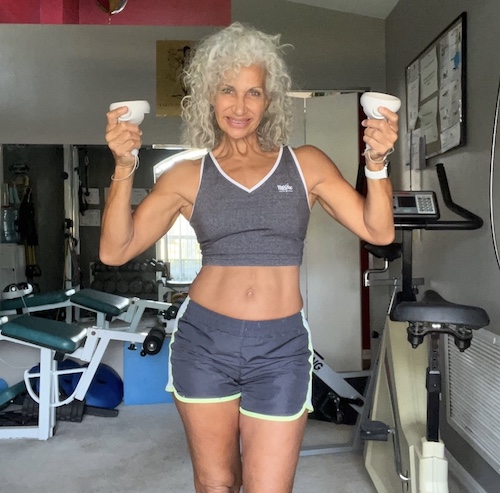 Karen Joseph had no idea what was happening years ago when the first symptoms of neuropathy began.
Karen Joseph had no idea what was happening years ago when the first symptoms of neuropathy began.
She assumed the pain and numbness in her legs were from a spinal injury she suffered in a car crash.
But after her diagnosis in 2014, Karen learned how debilitating neuropathy can be. And she had to make changes to her workouts.
“I could have gone on disability back then, but I knew I needed to move,” she says now at 65. She lost speed and agility and worried about falling. Running turned her legs to concrete, and power-walking didn’t get her heart rate up enough.
Karen is a retired Army officer and former bodybuilding champion, as well as a longtime personal trainer. After neuropathy hit, she had to find new ways to keep herself in top condition. Most of her clients are over 50, and some have neuropathy themselves — weakness and numbness due to nerve damage.
“I downscaled it a bit, but I still do it,” Karen says. She also found help in a new high-tech tool using virtual reality.
What Is Neuropathy?
About 30 million Americans have “peripheral neuropathy,” according to the Foundation for Peripheral Neuropathy. Men get it a bit more than women, and the risk is higher for mature adults.
Neuropathy refers to disorders due to damage to the nervous system. Numbness and pain can occur, particularly in the feet and hands.
It has a range of causes, such as diabetes, traumatic injury, inflammatory infections, protein abnormalities, poor nutrition, and exposure to toxic chemicals.
“The best way to prevent peripheral neuropathy is to manage medical conditions that put you at risk, such as diabetes, alcoholism, or rheumatoid arthritis,” says the Mayo Clinic.
Regular exercise and a proper diet also help prevent it. After diagnosis, exercise can reduce the pain and fight symptoms.
See your doctor if you experience numbness or tingling in feet and hands; extreme sensitivity to touch; lack of coordination and falling; and muscle weakness.
How Fitness Helped
For Karen, exercise has been a part of her life forever, and she can’t imagine stopping because of her age or condition.
In addition to working out with weights, Karen has found great cardio exercises using the Supernatural app on her Oculus virtual reality system.
“I can get my heart rate up to 160, 170 beats per minute, and I can work out for two hours,” she says. Participants practice boxing moves or strike moving virtual targets with virtual bats, set to popular music, and in immersive environments like mountaintops and desserts. The choreography also helps cognitively.
“I’m soaked when I’m finished. My heart rate is up. It’s a workout,” Karen says. “Anything I can do that makes me feel like me and makes me feel functional, I love that.”
Exercise is good for all kinds of chronic conditions. There is hope! Let us show you.
Holly Kouvo is a personal trainer, functional aging specialist, senior fitness specialist, brain health trainer, writer, and speaker.

